Sienna is an earth pigment containing iron oxide and manganese oxide. In its natural state, it is yellowish brown and is called raw sienna. When heated, it becomes a reddish brown and is called burnt sienna. It takes its name from the city-state of Siena, where it was produced during the Renaissance. Along with ochre and umber, it was one of the first pigments to be used by humans, and is found in many cave paintings. Since the Renaissance, it has been one of the brown pigments most widely used by artists.

Brown is a color. It can be considered a composite color, but it is mainly a darker shade of orange. In the CMYK color model used in printing or painting, brown is usually made by combining the colors orange and black. In the RGB color model used to project colors onto television screens and computer monitors, brown combines red and green.

Ochre, or ocher in American English, is a natural clay earth pigment, a mixture of ferric oxide and varying amounts of clay and sand. It ranges in colour from yellow to deep orange or brown. It is also the name of the colours produced by this pigment, especially a light brownish-yellow. A variant of ochre containing a large amount of hematite, or dehydrated iron oxide, has a reddish tint known as "red ochre".
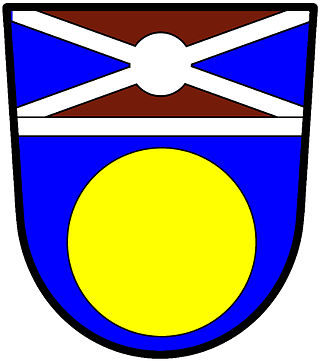
In heraldry, murrey is a "stain", i. e. a non-standard tincture, that is a dark reddish purple colour. It is most proximate in appearance to the heraldic tincture of purpure, but is distinct therefrom.

The meadow brown is a butterfly found in the Palearctic realm. Its range includes Europe south of 62°N, Russia eastwards to the Urals, Asia Minor, Iraq, Iran, North Africa and the Canary Islands. The larvae feed on grasses.

Sorrel is a reddish coat color in a horse lacking any black. It is a term that is usually synonymous with chestnut and one of the most common coat colors in horses. Some regions and breed registries distinguish it from chestnut, defining sorrel as a light, coppery shade, and chestnut as a browner shade. However, in terms of equine coat color genetics there is no known difference between sorrel and chestnut. Solid reddish-brown color is a base color of horses, caused by the recessive e gene.
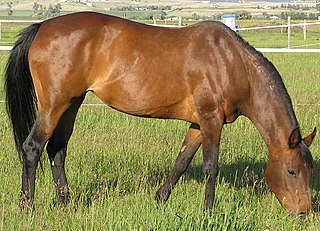
Bay is a hair coat color of horses, characterized by a reddish-brown or brown body color with a black point coloration on the mane, tail, ear edges, and lower legs. Bay is one of the most common coat colors in many horse breeds.
At right is displayed the color traditionally called liver.

Hōjicha is a Japanese green tea. It is distinctive from other Japanese green teas because it is roasted in a porcelain pot over charcoal. It is roasted at 150 °C (302 °F) to prevent oxidation and produce a light golden colour, as opposed to other Japanese teas which are steamed. In general, the base of a hōjicha consists of leaves from the second harvest or after.
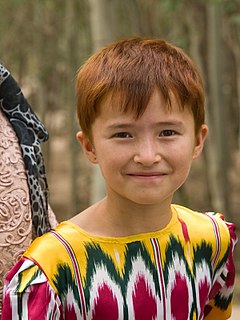
Auburn hair is a human hair color, a variety of red hair, most commonly described as reddish-brown in color or dark ginger. Auburn hair ranges in shades from medium to dark. It can be found with a wide array of skin tones and eye colors. The chemical pigments that cause the coloration of auburn hair are frequently pheomelanin with high levels of eumelanin; however, the auburn hair is due to a mutated melanocortin 1 receptor gene in Northwestern European people and by a mutated TYRP1 gene in the Melanesians and Austronesians, both genes that reduce the melanin production of the hair cells.

Chestnut is a hair coat color of horses consisting of a reddish-to-brown coat with a mane and tail the same or lighter in color than the coat. Chestnut is characterized by the absolute absence of true black hairs. It is one of the most common horse coat colors, seen in almost every breed of horse.

Gymnopilus luteofolius, known as the yellow-gilled gymnopilus, is a large and widely distributed mushroom that grows in dense clusters on dead hardwoods and conifers. It grows in late July to November in the east and in the winter on the west coast of North America. It has a rusty orange spore print and a bitter taste.

Kelaart's pipistrelle is a species of vesper bat found in southern and south-eastern Asia from Pakistan to Indonesia.
In mycology a tissue or feature is said to be amyloid if it has a positive amyloid reaction when subjected to a crude chemical test using iodine as an ingredient of either Melzer's reagent or Lugol's solution, producing a blue to blue-black staining. The term "amyloid" is derived from the Latin amyloideus ("starch-like"). It refers to the fact that starch gives a similar reaction, also called an amyloid reaction. The test can be on microscopic features, such as spore walls or hyphal walls, or the apical apparatus or entire ascus wall of an ascus, or be a macroscopic reaction on tissue where a drop of the reagent is applied. Negative reactions, called inamyloid or nonamyloid, are for structures that remain pale yellow-brown or clear. A reaction producing a deep reddish to reddish-brown staining is either termed a dextrinoid reaction or a hemiamyloid reaction.

The Natal red rock hare or greater red rock hare is a species of mammal in the family Leporidae. It has a slightly grizzled, grayish brown head and reddish brown upperparts. The dense fur is thick and rougher than other rock hares. It is endemic to Africa, and found in southeastern provinces of South Africa, eastern Lesotho, Eswatini, and southern Mozambique. It is a herbivore, primarily feeding on grass. It breeds throughout the year, and one or two pups are usually born in the summer. It is rated as a species of least concern on the IUCN Red List of Endangered Species.

Gymnopilus purpuratus is a species of agaric fungus in the family Hymenogastraceae. It grows in clusters on dead wood, tree stumps and wood chip mulch. It is widely distributed and has been recorded in Argentina, Australia, Chile, New Zealand, the UK and Germany. It has a broadly convex cap covered in small dry reddish-brown scales, a stout yellow stem beneath reddish brown, wine-red to purple vertical fibres, and a thick rusty orange spore print.
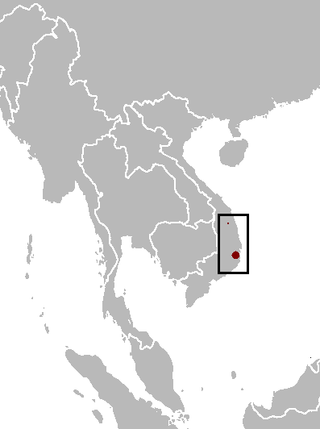
The Vietnam mouse-deer, also known as the silver-backed chevrotain, is an even-toed ungulate in the family Tragulidae known only from Vietnam. It was first described in 1910 by British zoologist Oldfield Thomas, who procured four specimens from Nha Trang in Annam. Little is known about its distribution and ecology. After 1910, the Vietnam mouse-deer was reported next in 1990 near Dak Rong and Buon Luoi in the Gia Lai Province. With increasing hunting pressure, habitat loss due to deforestation and no more reports of the species in the wild, the mouse-deer was feared to have gone extinct. The IUCN listed the species as Data Deficient in 2008. In 2019, a study confirmed the presence of the Vietnam mouse-deer in dry low-lying forests of southern Vietnam with camera trap evidence. The mouse-deer is characterised by a rough coat with a strange double-tone coloration unseen in other chevrotains; the front part of the body is reddish brown and contrasts strongly with the greyish posterior. It has big reddish brown ears, white and dark reddish brown marks on the throat.

Seal brown is a hair coat color of horses characterized by a near-black body color; with black points, the mane, tail and legs; but also reddish or tan areas around the eyes, muzzle, behind the elbow and in front of the stifle. The term is not to be confused with "brown", which is used by some breed registries to refer to either a seal brown horse or to a dark bay without the additional characteristics of seal brown.

Durrell's vontsira is a small, reddish-brown, fox-like mammal native to the island of Madagascar. Discovered in 2004, it lives only in the biodiverse wetlands of Lake Alaotra. Durrell's vontsira belongs to the family Eupleridae, a group of meat-eating, cat- or fox-like mammals found only on Madagascar. The species is closely related to the brown-tailed mongoose, with which it forms the genus Salanoia. The two are genetically similar, but morphologically distinct, and S. durrelli was described as a new species in 2010.
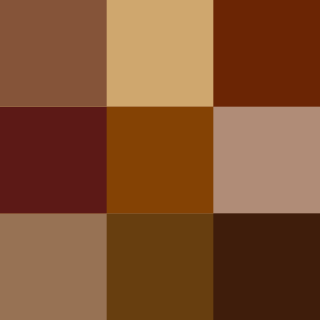
Shades of brown can be produced by combining red, yellow, and black pigments, or by a combination of orange and black—illustrated in the color box. The RGB color model, that generates all colors on computer and television screens, makes brown by combining red and green light at different intensities. Brown color names are often imprecise, and some shades, such as beige, can refer to lighter rather than darker shades of yellow and red. Such colors are less saturated than colors perceived to be orange. Browns are usually described as light or dark, reddish, yellowish, or gray-brown. There are no standardized names for shades of brown; the same shade may have different names on different color lists, and sometimes one name can refer to several very different colors. The X11 color list of web colors has seventeen different shades of brown, but the complete list of browns is much longer.














